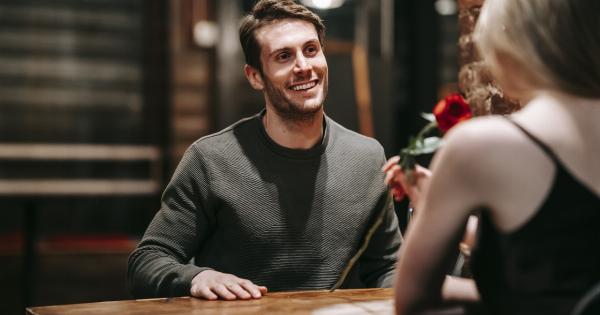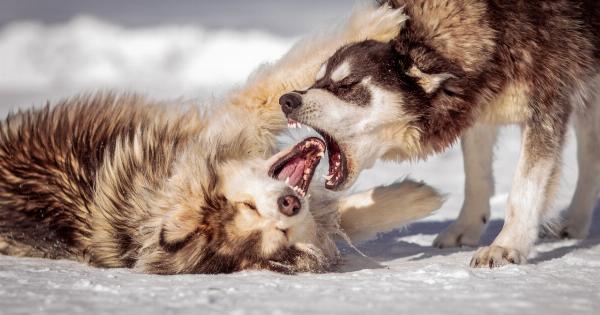Meeting new dogs can be an exciting experience for both humans and their furry friends. However, it is not uncommon for some dogs to growl when encountering unfamiliar canines.
This behavior can be perplexing and concerning for dog owners, but it is important to understand the reasons behind it. In this article, we will explore why some dogs growl when meeting new dogs and provide insights into this behavior.
Territorial Instincts
One of the primary reasons why dogs growl when encountering new dogs is their territorial instincts. Dogs are descendants of wolves, who are known for their strong territorial behavior.
When dogs growl at unfamiliar dogs, it is often their way of expressing a protective nature over their territory or personal space. They are essentially communicating that they feel threatened or that their boundaries are being invaded.
It is important to note that this territorial behavior is more commonly observed in dogs that have not been properly socialized or exposed to different environments and dogs during their early development stages.
Dogs who are not adequately socialized may view all other dogs as potential intruders and react with growling or aggression as a means of protecting what they perceive as their territory.
Fear or Anxiety
Another significant factor that can contribute to growling when meeting new dogs is fear or anxiety. Dogs, like humans, can feel scared or anxious in unfamiliar situations or when faced with new stimuli.
When a dog feels threatened or overwhelmed, growling can be a defensive response to communicate their discomfort.
This fear or anxiety can stem from previous negative experiences with other dogs, such as an attack or a traumatic encounter.
It can also result from a lack of exposure to various social situations, causing the dog to feel insecure or uncertain when meeting new dogs. In such cases, growling serves as a protective mechanism, signaling their unease and attempting to maintain distance from perceived threats.
Communication and Establishing Hierarchy
Dogs have their unique ways of communication, and growling is one of the ways they express themselves. When dogs growl during initial interactions, it can be a form of communication for establishing a social hierarchy.
This is especially true if the dogs are not familiar with each other and need to determine which dog will take on the role of the dominant one.
Growling can, therefore, serve as a means for dogs to negotiate their positions and determine who is in charge. It is a way for dogs to communicate their boundaries and assert their rank in the presence of unfamiliar dogs.
Understanding this natural instinct can help owners create a safe and positive environment for their dogs to establish healthy relationships with other canines.
Protection of Resources
Some dogs may growl at new dogs due to resource guarding tendencies. Resource guarding refers to the instinctive behavior of protecting valuable possessions, such as food, toys, or even attention, from other dogs or individuals.
When dogs growl during initial encounters, it can be an indication that they perceive the new dog as a potential threat to their resources.
Resource guarding behaviors can stem from a variety of factors, including genetics, past experiences, or a lack of proper training and socialization.
Dogs that exhibit resource guarding tendencies may growl to deter other dogs from approaching them or their valued possessions. It is essential for owners to address and manage this behavior to prevent potential conflicts or aggression.
Overexcitement and Overstimulation
While growling during initial interactions is often associated with fear or aggression, it is essential to recognize that some dogs may growl out of sheer overexcitement or overstimulation.
When dogs are overly enthusiastic or aroused during a meeting with new dogs, they may express their excitement through growling.
This type of growling is generally accompanied by other signs of excitement, such as wagging tails, jumping, and a high energy level. It is crucial for owners to discern between aggression-based growling and growling caused by overexcitement.
Overexcited growling is not necessarily dangerous but should still be managed appropriately to ensure a controlled and positive interaction.
Improper Introductions
The way dogs are introduced to each other can greatly impact their initial reactions.
Improper introductions, such as sudden face-to-face encounters or off-leash meetings without prior acquaintance, can trigger a defensive or aggressive response in dogs. This can result in growling as a warning sign to keep the other dog at a distance.
It is crucial for owners to introduce dogs in a controlled and gradual manner to avoid potential conflicts. Proper introductions involve neutral spaces, leashed meetings, and allowing the dogs to approach each other at their own pace.
This approach reduces the likelihood of growling and promotes positive associations between the dogs.
Past Negative Experiences
Past negative experiences with other dogs can significantly influence a dog’s behavior when meeting new canines.
If a dog has been bullied, attacked, or frightened by another dog previously, their natural response may be to growl as a preemptive defense mechanism.
These experiences leave a lasting impact on a dog’s emotional state, creating a sense of insecurity or fear.
It is crucial for owners to be understanding and patient when introducing dogs with such histories, as it may require gradual desensitization and counterconditioning to help them overcome their negative associations and develop healthier interactions.
Tips for Managing Growling Behavior
While growling is a natural behavior in certain circumstances, it is essential for owners to manage and address this behavior to ensure the safety and well-being of their dogs and others. Here are some tips for managing growling behavior:.
1. Socialization
Early and proper socialization is key to helping dogs develop positive associations with other canines. Exposing them to various environments, situations, and dogs from a young age can help prevent fear or aggression-based growling in the future.
2. Create Positive Experiences
When introducing dogs to new canines, aim to create positive experiences by offering treats, praise, and rewards. This helps dogs associate the presence of other dogs with positive outcomes and reduces the likelihood of growling.
3. Consult a Professional
If your dog consistently displays aggressive or fearful behaviors when meeting new dogs, seeking guidance from a professional dog trainer or behaviorist is highly recommended.
They can assess the situation, provide tailored advice, and develop a training plan to address the underlying causes of growling.
4. Gradual Introductions
When introducing dogs to each other, do so gradually and in controlled environments. Start with neutral spaces where neither dog feels territorial and allow them to interact on-leash while monitoring their body language and behavior.
Gradually increase the exposure and duration of their interactions, always prioritizing safety and positive experiences.
5. Reinforce Basic Commands
Teaching and reinforcing basic obedience commands such as “sit,” “stay,” and “leave it” can help redirect a dog’s attention and provide a semblance of control during interactions with new dogs.
These commands also establish you as the leader and enable you to manage potentially challenging situations more effectively.
6. Address Resource Guarding
If your dog growls due to resource guarding tendencies, it is essential to address this behavior through positive reinforcement training and gradual desensitization.
Consult a professional to develop a tailored plan that focuses on rewarding your dog for sharing and relinquishing resources.
7. Remain Calm and Patient
During interactions with new dogs, it is important for owners to remain calm, patient, and avoid displaying signs of anxiety or tension.
Dogs are highly perceptive of their owners’ emotions, and displaying calmness can help alleviate their apprehensions and create a more positive atmosphere.
Conclusion
Growing when meeting new dogs is a behavior that can stem from various factors, including territorial instincts, fear or anxiety, communication and establishing hierarchy, resource guarding, overexcitement, improper introductions, and past negative experiences. While some level of growling can be considered normal, it is vital for owners to understand the underlying reasons behind this behavior and take appropriate measures to manage and address it.
Early socialization, positive experiences, professional guidance, gradual introductions, reinforcing obedience commands, addressing resource guarding, and remaining calm and patient are essential in promoting positive interactions between dogs and preventing potential conflicts.



























